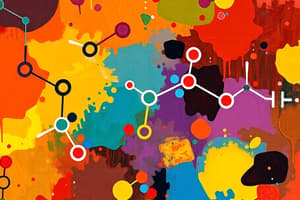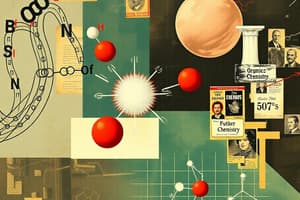Podcast
Questions and Answers
What are the 7 basic functional groups?
What are the 7 basic functional groups?
- Hydroxyl (correct)
- Sulfhydryl (correct)
- Phosphate (correct)
- Carbonyl (correct)
- Carboxyl (correct)
- Amino (correct)
- Methyl (correct)
What functional group is hydroxyl?
What functional group is hydroxyl?
Hydroxyl
What functional group is carbonyl?
What functional group is carbonyl?
Carbonyl
What functional group is carboxyl?
What functional group is carboxyl?
What functional group is amino?
What functional group is amino?
What functional group is sulfhydryl?
What functional group is sulfhydryl?
What functional group is phosphate?
What functional group is phosphate?
What functional group is methyl?
What functional group is methyl?
List the generic name(s) for molecules carrying a hydroxyl group:
List the generic name(s) for molecules carrying a hydroxyl group:
List the generic name(s) for molecules carrying a carbonyl group:
List the generic name(s) for molecules carrying a carbonyl group:
List the generic name(s) for molecules carrying a carboxyl group:
List the generic name(s) for molecules carrying a carboxyl group:
List the generic name(s) for molecules carrying an amino group:
List the generic name(s) for molecules carrying an amino group:
List the generic name(s) for molecules carrying a sulfhydryl group:
List the generic name(s) for molecules carrying a sulfhydryl group:
List the generic name(s) for molecules carrying a methyl group:
List the generic name(s) for molecules carrying a methyl group:
List the generic name(s) for molecules carrying a phosphate group:
List the generic name(s) for molecules carrying a phosphate group:
What compound is ethanol and what functional group(s) can you see?
What compound is ethanol and what functional group(s) can you see?
What compound is acetone and what functional group(s) can you see?
What compound is acetone and what functional group(s) can you see?
What compound is propanol and what functional group(s) can you see?
What compound is propanol and what functional group(s) can you see?
What compound is acetic acid and what functional group(s) can you see?
What compound is acetic acid and what functional group(s) can you see?
What compound is glycine and what functional group(s) can you see?
What compound is glycine and what functional group(s) can you see?
What compound is cysteine and what functional group(s) can you see?
What compound is cysteine and what functional group(s) can you see?
What compound is glycerol phosphate and what functional group(s) can you see?
What compound is glycerol phosphate and what functional group(s) can you see?
What compound is 5-methyl cytidine and what functional group(s) can you see?
What compound is 5-methyl cytidine and what functional group(s) can you see?
What are the functional properties of hydroxyl groups?
What are the functional properties of hydroxyl groups?
What group gives rise to two major groups of sugars?
What group gives rise to two major groups of sugars?
What is the major functional property of carboxyl groups?
What is the major functional property of carboxyl groups?
What are the functional properties of amino groups?
What are the functional properties of amino groups?
What are the functional properties of sulfhydryl groups?
What are the functional properties of sulfhydryl groups?
What are the functional properties of phosphate groups?
What are the functional properties of phosphate groups?
What are the functional properties of methyl groups?
What are the functional properties of methyl groups?
In what prominent biological molecule(s) will we find carbonyl groups?
In what prominent biological molecule(s) will we find carbonyl groups?
If a carbonyl group is found within a carbon skeleton, that molecule is known as a what?
If a carbonyl group is found within a carbon skeleton, that molecule is known as a what?
If a carbonyl group is found on the end of a carbon skeleton, that molecule is known as a what?
If a carbonyl group is found on the end of a carbon skeleton, that molecule is known as a what?
True or false, a ketone and an aldehyde can be structural isomers with different characteristics?
True or false, a ketone and an aldehyde can be structural isomers with different characteristics?
What allows the carboxyl group to act as an acid?
What allows the carboxyl group to act as an acid?
In what prominent biological molecule(s) will we find amino groups?
In what prominent biological molecule(s) will we find amino groups?
What are compounds with both amino acids and carboxyl groups called?
What are compounds with both amino acids and carboxyl groups called?
Flashcards
Functional Groups
Functional Groups
Specific arrangements of atoms that attach to carbon skeletons and give a molecule its unique properties.
Hydroxyl Group
Hydroxyl Group
A functional group containing an oxygen atom bonded to a hydrogen atom (-OH).
Carbonyl Group
Carbonyl Group
A functional group containing a carbon atom double-bonded to an oxygen atom (C=O).
Carboxyl Group
Carboxyl Group
Signup and view all the flashcards
Amino Group
Amino Group
Signup and view all the flashcards
Sulfhydryl Group
Sulfhydryl Group
Signup and view all the flashcards
Phosphate Group
Phosphate Group
Signup and view all the flashcards
Methyl Group
Methyl Group
Signup and view all the flashcards
Alcohols
Alcohols
Signup and view all the flashcards
Ketones
Ketones
Signup and view all the flashcards
Aldehydes
Aldehydes
Signup and view all the flashcards
Carboxylic Acids
Carboxylic Acids
Signup and view all the flashcards
Amines
Amines
Signup and view all the flashcards
Thiols
Thiols
Signup and view all the flashcards
Organic Phosphates
Organic Phosphates
Signup and view all the flashcards
Methylated Compounds
Methylated Compounds
Signup and view all the flashcards
Hydrogen Bonding
Hydrogen Bonding
Signup and view all the flashcards
Polarity
Polarity
Signup and view all the flashcards
Hydrophilic
Hydrophilic
Signup and view all the flashcards
Hydrophobic
Hydrophobic
Signup and view all the flashcards
Acidic
Acidic
Signup and view all the flashcards
Basic
Basic
Signup and view all the flashcards
Disulfide Bonds
Disulfide Bonds
Signup and view all the flashcards
Hydrolysis
Hydrolysis
Signup and view all the flashcards
Energy Transfer
Energy Transfer
Signup and view all the flashcards
Gene Expression
Gene Expression
Signup and view all the flashcards
Molecular Interactions
Molecular Interactions
Signup and view all the flashcards
Metabolic Pathways
Metabolic Pathways
Signup and view all the flashcards
Structural Integrity
Structural Integrity
Signup and view all the flashcards
Study Notes
Functional Groups Overview
- Seven basic functional groups: Hydroxyl, Carbonyl, Carboxyl, Amino, Sulfhydryl, Phosphate, Methyl
- Functional groups are key to biological molecules' structure and reactivity.
Hydroxyl Group
- Found in alcohols.
- Characterized by its ability to form hydrogen bonds, making compounds polar and hydrophilic, enhancing solubility in water.
Carbonyl Group
- Includes ketones (if within a carbon skeleton) and aldehydes (if at the end of a carbon skeleton).
- Gives rise to two major types of sugars (aldoses and ketoses).
Carboxyl Group
- Found in carboxylic acids.
- Functions as an acid due to the polar covalent bond between oxygen and hydrogen, allowing hydrogen ion release.
Amino Group
- Present in amines, critical for protein structure.
- Acts as a base, capable of accepting protons in biological reactions.
Sulfhydryl Group
- Characteristic of thiols.
- Stabilizes protein structure by forming disulfide bonds, important in the structure of proteins like keratin.
Phosphate Group
- Found in organic phosphates.
- Contributes a negative charge, involved in energy transfer (ATP) and can react with water, releasing energy.
Methyl Group
- Associated with methylated compounds.
- Influences gene expression and hormones, affecting molecular interactions and biological pathways.
Key Properties of Functional Groups
- Hydroxyl Groups: Polar, form hydrogen bonds, and increase solubility in water.
- Carboxyl Groups: Are acidic, releasing H⁺ ions.
- Amino Groups: Basic, accepting protons to become positively charged.
- Sulfhydryl Groups: Stabilize protein structures through cross-linking.
- Phosphate Groups: Negatively charged, releases energy during hydrolysis.
- Methyl Groups: Provide non-polar characteristics, affecting gene regulation.
Biological Importance
- Functional groups define the characteristics of biomolecules, affecting their interactions and roles in biological systems.
- Molecules possessing these groups play significant roles in metabolic pathways, structural integrity, and energy transfer.
Studying That Suits You
Use AI to generate personalized quizzes and flashcards to suit your learning preferences.




